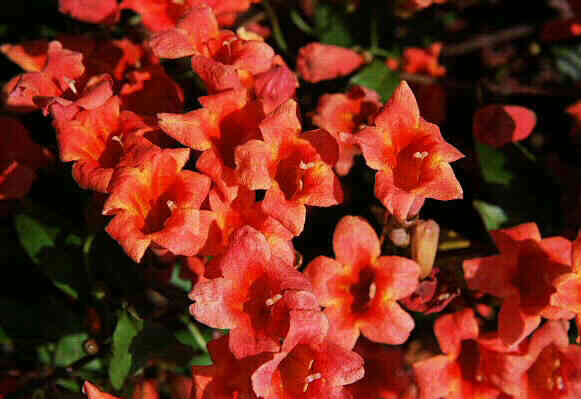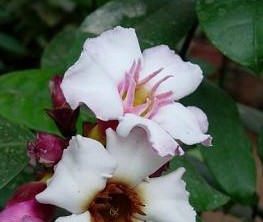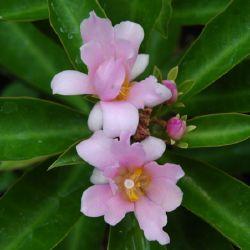


Creepers and Climbers
In the years gone by when most of the houses in Dehra Dun were built in 2 to 4 bigas ( 1500 to 3000 Sq. meter) area there was ample space for a proper landscaped garden. In these gardens one would always find some allocated area for the climbers. Most of these houses boasted of climbing Roses and the Bougainvilleas in all theirs shades such as deep purple, red, salmon-pink, white, and the variegated varieties.
In
The growth habit and vibrant colours give a charming appearance to any wall in the garden. Climbers are very commonly used on arches, walls and to provide privacy.
It is often felt that among the various types of ornamental plants least interest is taken on climbers and only few species or varieties are found growing in a locality.
Creepers : These plants can be grown along the top of the compound wall or as a cover for walls, or at the entrance as an arch. There are varieties of creepers available like, Bignonia venusta, allamanda, passiflora (fashion flower), Jacquemontia. Even Bougainvilleas can be a good creeper.
Climbers: These are the plants with soft stems that grow only with a support. They rely on something else for support; another plant, a wall or trellis. Different types of climbers have devised many crafty ways to hold on to whatever they grasp. Examples are Clerodendrum thomsoniae (Bleeding Heart), Cissus rhombifolia (Grape Ivy), Jasminum multipartitum (Starry Wild Jasmine), Clematis
Soil type:
Creepers and climbers grow best in planting medium made as under:
· Garden soil – 2 parts
· Farm yard manure – 1 part
A mixture of this should be applied to the previously dug up plot up to a height of 5 cm.
Fertiliser requirement:
Apply IFFCO 12-32-16 (25 gm per plant) or DAP (25 gm) + MOP 10 gm) per plant ever 15 days. Application can be made weekly during the flowering season.
Water requirement:
These plants need regular watering except during the monsoons. In winter apply water as required.
Light Requirement:
Since most of these varieties are Tropical they require a good amount of sunshine. A minimum of 4-6 hours of sunlight is must for proper growth and flowering.
Even a good amateur gardener seldom knows more than a dozen climbers as information regarding a large number of these plants are not readily available.
Today with smaller house plots and smaller gardens one can still add some climbers to the garden. The recommended climbers are as under:
Suggested varieties:
|
Ser No |
Common name |
Botanical name |
Description |
|
1 |
Garlic Vine • Manipuri: চনম লৈ Chanamlei • Bengali: লতা পাৰুল Lata parul |
Botanical name: Cydista aequinoctialis Family: Bignoniaceae (Jacaranda family) |
Native to |
|
2 |
Pink jasmine, Winter jasmine, Chinese jasmine • Hindi Gulabi chameli • Tamil: Jaadi-malli |
Botanical name: Jasminum polyanthum Family: Oleaceae (Jasmine family) |
Fast growing twining vine with glossy, compound leaves and very fragrant white flowers. Though called "Pink" it is only the buds that are pale pink. When opened the star-shaped flowers are pure white. Flowering is usually prolific, and growth is rampant. Vines reach a height of about 20 ft. Native to southeastern |
|
3 |
Glow Vine, Purple funnel vine, Purple bignonia |
Botanical name: Saritaea magnifica Family: Bignoniaceae (Jacaranda family) |
Glow Vine is a climbing shrub native to South America, cultivated as a garden plant in |
|
4 |
Kundo, Warakki Kundo (Manipuri), Kundamu malle (Telugu), Kunda (Hindi), |
Botanical name: Jasminum nervosum Family: Oleaceae (Jasmine family) |
Known by the name Warakki kundo, Jasminum nervosum is very popular in Manipur. In Manipur, it is considered to be a wild cousin of Jasminum multiflorum, also known as Kundo. It has very beautiful single-flowered, white blooms, which have no fragrance. It is a climbing shrub with very slender branchlets which are slightly pubescent when young. Leaves simple, ovate or lance-like ovate, 2-5.5 cm long, 1-3 cm wide, pointed at the tip and rounded at the base, with a short stalk. Flowers occur at the end of branches, either singly or in groups of three. Snow white flowers are large, with iwith 7-11 petals which are 9-13 cm long. The beauty of the flower more than makes up for lack of fragrance. In Indian mythology, Kunda is known for its whiteness. In Manipur, Kundo flowers are used in worship, and are an essential part of a marriage ceremony. The bride garlands the groom with two Kundo flower garlands. The groom then takes one of the two and garlands the bride. |
|
5 |
Flame vine |
Botanical name: Combretum coccineum Family: Combretaceae ( |
The name Combretum means climbing plant in Latin. This is a spectacular creeper providing a spring spectacle of flaming crimson, flowering splendour. Flame vin is a robust, deciduous climber, sometimes a scrambling shrub. Masses of small flowers with bright red petals and long stamens occur in panicles. The oval leaves are 13-60 mm long and 13-50 mm wide. The Combretaceae are trees, shrubs, and lianas comprising about 20 genera and 600 species. |
|
6 |
Bougainvillea |
Botanical name: Bougainvillea glabra Family: Nactaginaceae |
Bougainvillea is an evergreen vine which is just as happy spreading horizontally or hanging downwards as it is climbing upwards, it makes itself at home in almost any situation. It can be grown as a hedge, groomed as a ground cover, pruned as an espalier, trained as a tree or contained in a pot in a variety of shapes. Its trunk tends to be gnarled. Bougainvillea is ideal for bonsai. Red, violet, orange, yellow or white bracts appear on the ends of new growth. The white variety has recently been found in Bougainvillea are available in nurseries and from bonsai specialty growers. They flower most heavily in winter and early spring, but some plants put forth scattered clusters all year. The colors are found in tones of purple, lavender, carmine, scarlet, red, pink, orange, yellow and white. Single and double flower forms are available. Double forms tend to carry their blooms near the end of the stems rather than distributing them evenly over the plant. The colorful, papery "blooms" are not flowers; they are bracts. The true flower is white, trumpet shaped and almost unnoticeable within the bracts. Bougainvilleas are available in a variety of species, each having its unique characteristics. However, with judicious clipping and watering, the form of the plant and quantity of bloom can be controlled. It is perhaps at its best in Some suggested varieties are: abuttiana 'Mrs. Butt': - crimson bracts. Bougainvillea buttiana 'Orange King'. Bougainvillea glabra: paper flower, lesser bougainvillea - the most common species used for bonsai. It has shiny green, slightly hairy leaves and magenta colored bracts. Bougainvillea glabra 'Magnifica' - rose pink bracts. Bougainvillea glabra 'Snow White' - white bracts. Bougainvillea peruviana - rosy pink bracts. Bougainvillea spectabilis - pink or mauve bracts. |
|
7 |
Yellow Doll Rose |
Botanical name: |
Yellow Doll Rose is a beautiful miniature climbing rose which is commonly seen in hill stations like Mussoorie. Yellow double flowers are only slightly larger than thumb size. It is a shrub which climbs, and covers itself with bunches of small yellow flowers in the blooming season. Yellow Doll Rose is a recent hybrid |
|
8 |
Trumpet Creeper, Trumpet vine, Cow-Itch Vine |
Botanical name: Campsis radicans Family: Bignoniaceae (Jacaranda family) |
The trumpet creeper is a popular, fast growing, high climbing deciduous woody vine that will grow to heights up to 40 ft. The vine's aerial roots that occur along the stems that attach tightly to surfaces. Once the vine climbs to a certain height it grows horizontal branches that reach away from the support in a quest for light and space. Trumpet creeper produces pinnate compound leaves 4-12 in long that cover the vine in a dense cloak of bright green foliage. They are composed of 7-15 oval leaflets that have serrated edges and are 1-4 in long and 0.5-1.5 in wide. Showy clusters of yellow orange to red trumpet-shaped flowers first appear in summer and are produced continuously until early autumn. The tubular flower buds are 3 - 4 in long and are followed by seed capsule 4-8 in long that often hangs on the vine through the winter. |
|
9 |
Rangoon Creeper, |
Botanical name: Quisqualis indica Family: Combretaceae ( |
|
|
10 |
Passion fruit, Edible Passion Flower, Passion flower, Purple granadilla |
Botanical name: Passiflora edulis Family: Passifloraceae (passion flower family) |
he passion fruit is a vigorous, climbing vine that clings by tendrils to almost any support. It can grow 15 to 20 ft. per year once established and must have strong support. It is generally short-lived (5 to 7 years). The evergreen leaves of passion fruit are alternate, deeply 3-lobed when mature and finely toothed. They are 3 to 8 inches long, deep green and glossy above, paler and dull beneath and, like the young stems and tendrils, tinged with red or purple, specially in the yellow form. A single, fragrant flower, 2 to 3 inches wide, is born at each node on the new growth. The bloom, clasped by 3 large, green, lifelike bracts, consists of 5 greenish-white sepals, 5 white petals and a fringelike corona of straight, white-tipped rays, rich purple at the base. It also has 5 stamens with large anthers, the ovary and triple-branched style forming a prominent central structure. The passion fruit is round to oval, yellow or dark purple at maturity, with a soft to firm, juicy interior filled with numerous seeds. The fruit can be grown to eat or for its juice, which is often added to other fruit juices to enhance aroma. The unique flavor is appealing, musky, guava-like and sweet/tart to tart. Passion fruit is cultivated commercially for its fruit in northwestern |
|
11 |
Ragi • Marathi: Ragi • Assamese: Paniphigag-taraw, Bagasora, Kempu-ribui • Tamil: Kevaru |
Botanical name: Caesalpinia cucullata Family: Fabaceae (Pea family) |
Ragi is a large climbing shrub, with branches carrying curved prickles on corky tubercles (small knoblike structures). Leaves are 2-pinnate - rachis to 30 cm long, pinnae 2-5. Flowers fragrant, in terminal and axillary racemes 20-40cm. Yellow flowers appear like hoods with long stamens with red anthers, coming out. The species name cucullatum means hooded. Ragi is found a bit rarely in evergreen forests at higher elevations of the Sahyadri hills. It is much more abundant in north-east |
|
12 |
Climbing Begonia, Rex Begonia Vine, Painted Cissus • Manipuri: কোংগঙৌযেন লবা Kongngouyen laba • Nepalese: Jogi lahara |
Botanical name: Cissus javana Family: Vitaceae (Grape family) |
Climbing Begonia is not really a Begonia, but is a vine having large, decorated, Begonia-like leaves. It is a weak perennial climber with a woody base. Stems are prominently red and hairless, and trendrils are forked. Leaves are ovate-lanceshaped, with a heart-shaped base and a pointed tip, and margins finely toothed or bristly. Leaves are usually mottled with aluminium white above, and are purple on the underside. Flowers are tiny, yellowish, on red sepals cup and stalks, in small compound umbels, opposite to the leaves. |
|
13 |
Climbing Skullcap Nepalese: Chaarpaate |
Botanical name: Scutellaria scandens Family: Lamiaceae (Mint family) |
Climbing Skullcap is a tall perennial herbaceous plant, with long climbing 4-angled branches. This climbing plant produces lax spikes of pale yellow or whitish flowers with purple upper lips. The flower spikes are about 8-10 cm long. The flowers are 2-2.5 cm long, the upper lip hooded with margins in-curved. The notched lower lip is broader than long. Ovate-lancelike leaves, 2.5-8 cm long, are coarsely toothed, stalked and sometimes purple on the lower surface. Climbing Skullcap is found in shrubberies in the |
|
14 |
Climbing Oleander, Rose Allamanda |
Botanical name: Strophanthus gratus Family: Apocynaceae (oleander family) |
Climbing Oleander is an evergreen, clambering vine or rambling shrub, to 25 feet or more from |
|
15 |
White Coral Vine, Coral vine, Honolulu creeper, Mexican creeper • Tamil: Kodi rose • Bengali: Anantalata |
Botanical name: Antigonon leptopus 'Alba' Family: Polygonaceae (Knotweed family) |
This is the rare white variety of the normally pink coral vine. Coral Vine, is a native of |